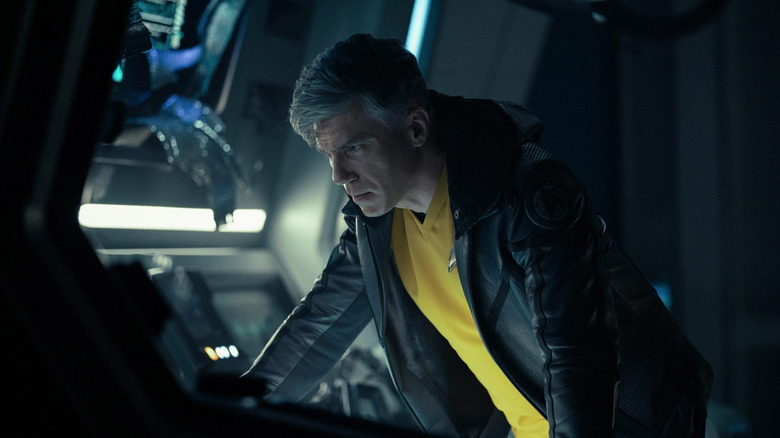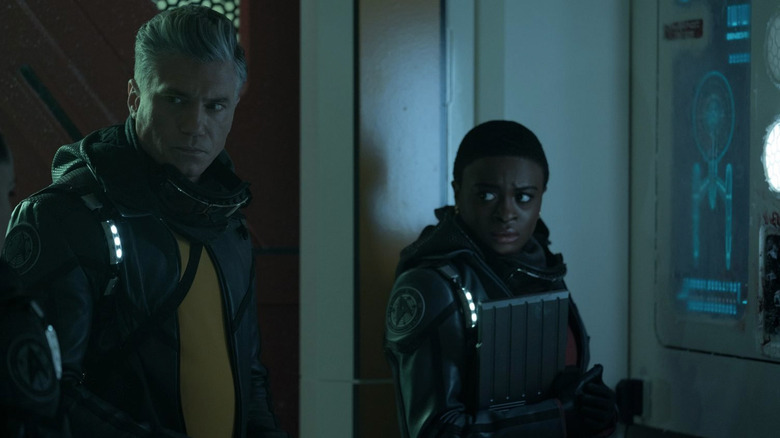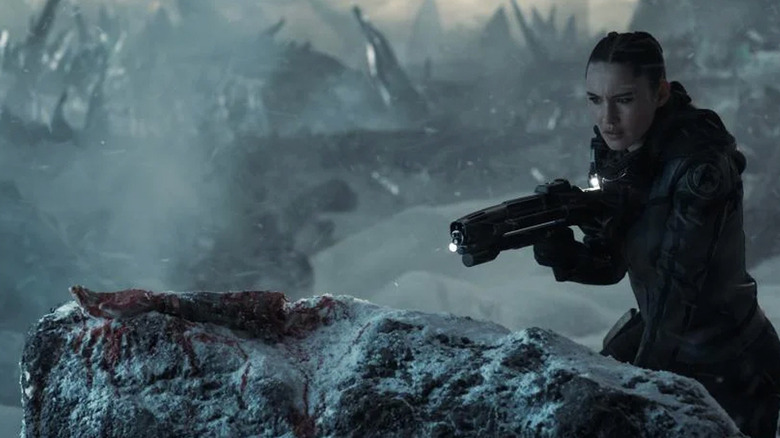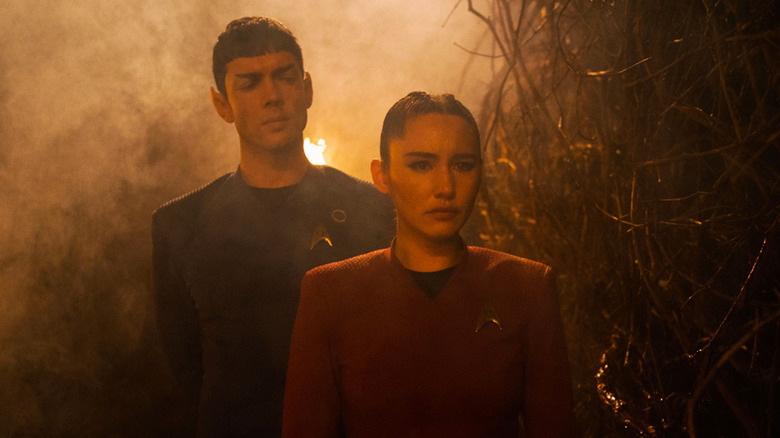Star Trek: Strange New Worlds Borrowed A Trick From Steven Spielberg
Sometimes, it's really the things you can't see that are actually the scariest. Horror films — particularly those that terrify their audiences with otherworldly creatures — have understood this for a long, long time. In some cases, teasing is a quick fix for a limited budget or less-than-realistic visual effects. But when used sparingly, the result is two-fold: it leaves so much to the imagination that the mere impression of a monster is more horrifying than a real glimpse of one.
Some of the best creature flicks have utilized this tactic brilliantly. It's synonymous with Steven Spielberg's "Jaws," which made the best of a sporadic shark animatronic named Bruce. Of course, Bruce's mechanical failures were just one of the many problems the plagued Spielberg on set — but malfunctioning machinery meant that a lot of shark footage ended up on the cutting room floor. Spielberg was forced to get creative, even deceptive, when depicting the movie monster.
"It's what we don't see that is truly frightening," the director later said of the tactic. He wasn't the first filmmaker to employ it — in fact, the art of concealing a threat has its roots in German Expressionism, not to mention Hitchcock's "Psycho." But Spielberg definitely took the method to new levels, and it's that same restraint that has since been recreated time and time again, most recently in "Star Trek: Strange New Worlds."
Seeing the light
"Strange New Worlds" — and most "Trek" shows, really — have always made equal use of both visual and practical effects. Even in the age of high-budget TV, it's best not to rely too heavily on the ever-evolving qualities of CGI, something that "Strange New Worlds" co-creator Alex Kurtzman understands all too well. "The purist in me always wants to go back to the kinds of movies that I was raised on," Kurtzman told Wil Wheaton on "The Ready Room" (via Trek Movie).
Kurtzman grew up loving films like "Jaws" and James Cameron's "Aliens," just two examples of "master filmmakers creating incredible puppetry." He continued:
"I just watched 'Aliens' again recently and it's still pretty flawless. But part of why – and [James] Cameron understands this, and [Steven] Spielberg understands this – is that the way you light those things is everything. And the duration of those shots is everything. If you over-light and stick your eye... you have to tease and you have to build it. And obviously, that precedent was set in some ways by [Alfred] Hitchcock, but then 'Jaws' took it to a whole other level. Just seeing this rubber fin in the water, but your brain is inventing what's underneath the surface so when you see the shark — even though you might go, 'Well, that doesn't exactly look like a real shark' — you've utterly accepted it at that point."
The best of both worlds
When it came time to reintroduce the Gorn, one of the franchise's oldest adversaries, to the new "Trek" series, Kurtzman had a bevy of options at his disposal. "What instantly got me excited was that, in the age of 'Game of Thrones' post-'Jurassic Park,' the technology is there now to make the Gorn really vivid and scary. Not just a guy in a rubber suit," Kurtzman explained.
The Gorn's first appearance in the original "Star Trek" series was, by today's standards, that "rubber suit" effect exactly. Their second appearance years later, in "Star Trek: Enterprise," sits on the opposite side of the effects spectrum. "Enterprise" took full advantage of the new powers of CGI, rendering the Gorn without any practical suits. Unfortunately it didn't age very well either, but Kurtzman was determined not to make the same mistakes with "Strange New Worlds":
"The trick was, your first instinct was, 'Let's do it as a full CG character' ... And so the game you play with the Gorn, which is, 'Okay we can't actually afford to do full CG characters,' because that's a wildly expensive proposition on a television budget. So how do you merge the two? How do you use puppetry and how do you use CG? And in what way? And how do you light it?"
Out of sight...
Kurtzman's solution was, essentially, to take a page from Spielberg's book. Though the Gorn are an ever-present villain throughout "Strange New Worlds," they're scarcely seen, but mentioned and referenced often. As early as the very first episode, their terrifying practices are relayed through a character that has survived the Gorn, La'an Noonien-Singh. The series' fourth episode, "Memento Mori," expands on La'an's experience with the Gorn when the Enterprise encounters a Gorn ship. The Gorn present a serious threat to the Enterprise — we even get a glimpse at La'an's own experiences with the species — but we never actually see any.
Of course, this all changes with this week's horror-influenced episode "All Those Who Wander," which finds the Enterprise crew facing off against Gorn hatchlings on a crashed Federation ship, "Alien" style. It's absolutely terrifying stuff, but it still makes perfect use of the "what we don't see" tactic. With a combination of CGI and practical effects, "Strange New Worlds" has successfully rebooted the Gorn as a truly blood-chilling adversary, one we'll hopefully be seeing more (or less) of in the future.



